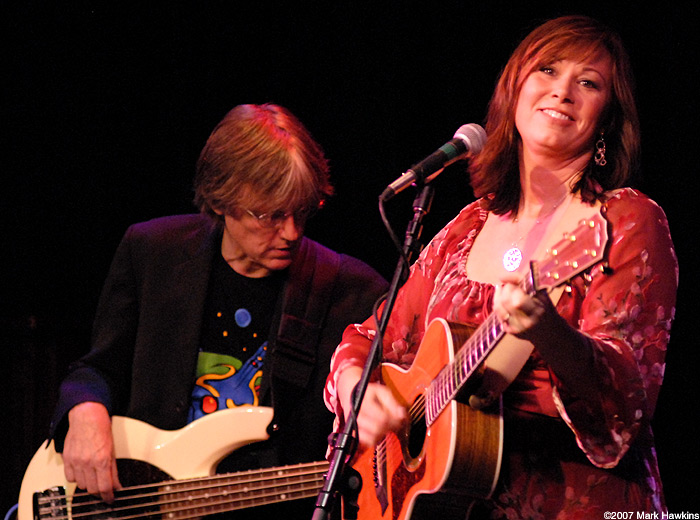

 |
Interview
with County Music's Suzy Bogguss |
|
Although
country fans have since the late 1980’s recognized that Suzy Bogguss is an
incredibly gifted singer and songwriter, it was with her last CD
Swing
in 2003, that non country music fans first experienced Bogguss’ excellence as a
vocalist. Although she set out to make a country swing album,
Swing
was widely embraced, and critically acclaimed within the jazz community. With
her current CD
Sweet Danger,
the two-time recipient of a Country Music Association award has stretched the
boundaries again, and this time we can anticipate that the pop music community
will warmly embrace her music. Bogguss can no longer be pigeonholed as a cowgirl
with a guitar and a song, but she has a right to expect that critics, and fans
alike will simply refer to her as one of today’s top vocalists. Bogguss recently took time
out from promoting her CD, touring, being a mother to her son, and a wife to
songwriter Doug Crider, to talk to me on the phone from her home in Nashville.
Having a conversation with Bogguss is a lot like sitting down for a chat with an
old friend, she is affable, witty and laughs easily. The girl who started life
in the small town of Aledo Illinois, and has become a platinum selling recording
artist, talked about
Sweet Danger,
the previous CD
Swing, and the
things she values most in life.
“As time went on I wanted to
make sure that the personalities (of the musicians) were coming into play with
the material. I always tried to make sure that with whatever band we had in the
studio that I made the best of the situation that I was given. I have always had
a feel for pop music, but I might have had a bluegrass guy, so I would throw him
into the mix.
I used these amazing players, who were artists
in their own right, and created the music in that way. That is the way it has
always been for me, putting different types of people together, to make
something that doesn’t have just one sound, but has a lot of personality from a
lot of different things,” says Bogguss.
When
she set out to create
Swing in 2003,
Bogguss did not anticipate just how much she was about to stretch as an artist.
She recalls hooking up with producer Ray Benson from the country music group
Asleep
At The Wheel, “I had known Ray (Benson)
for a really long time, as a performer and as a friend. I had opened some shows
for
Asleep At The Wheel, back in the eighties
in “When I got down there, I
learned so much about him, and what a musicologist he is. He can play any style
of guitar. He can play any pickin’ chicken style of country that you would ever
want, but he can also play blues and swing, like the old players from the
thirties. His diversity was pretty eye opening for me. He is renowned for that
Bob Wills type of sound, but he was also thinking horn charts. Over the years, I
had been around him tons, but mostly in show positions where we were doing the
music that we were known for. When I thought
of Ray, I would think of “House of Blue Lights,” stuff that sounded like Bob
Wills, but when I got in there, and he was picking along, I was amazed at the
depth of his guitar playing. There was much more to it than, hey let’s slap
together some cover tunes,” says Bogguss.
In part,
Swing
caught the ear, and captured the imaginations of those inside and outside the
music industry, because Benson and Bogguss took a step back in time. Instead of
sequestering the singer and all the musicians into their own little corners, the
pianist (Floyd Domino), guitarist (Benson) and Bogguss were in the same room.
She says, “There was not a lot of going back and fixing
stuff. We were sitting there together, their parts were bleeding onto my mic,
and my parts were bleeding onto their mics. There was a live quality (to the
recording).” Despite pulling out a lot of
creative stops, the warm reception that
Swing
received still surprised Bogguss. “It flattered me, because I don’t think of
myself as having all that much of a jazz quality to my voice. It made me happy
(that the jazz community accepted it so well), because it is something that I
have always loved. It made me happy that they didn’t think of it as a novelty,
or that they thought I was just trying to be cute. I was having fun, but I
wasn’t trying to be clever with it. I was just having a really good time singing
something that I have always loved.” “After I did the
Swing
album, I really thought that I would go do another swing album, because I had so
much fun, and I loved touring it. It was just a blast,” she says. However, one swing album did not beget another one,
because there was still something missing from the mix as far as the singer was
concerned. “In the back of my mind, I was thinking that about making a real
singer/songwriter type of record. As much as I was enjoying the swing thing,
there was a part of being able to perform a song by myself that was missing,”
she notes. “For this album,
Sweet Danger,
I tried to direct more singer/songwriter type messages, with really intimate
stories and themes. It is also very acoustic, which was one of my biggest goals.
If I go and play a solo gig, I want to be able to play these songs by myself,”
says Bogguss, in comparing her current CD to
Swing,
which was equally reliant on instrumental solos as it was lyrics. While Bogguss was still in
the creative percolating stage for her next project, which would become,
Sweet Danger,
renowned producer Jason Miles (Miles Davis, Sting, Luther Vandross), caught her
act at New York City’s B.B. King’s. At the time, she was touring her
Swing
CD. Miles loved her music, and wanted to know what her next project was going to
be. “It just spurted out of my
mouth, ‘I don’t know. What are you doing?’
I didn’t think at the time that he would take
me seriously, but he said hey let’s do a project together. We decided to try a
few songs, and once again, I thought that we were going to make a cowboy swing
record,” says Bogguss, while disclosing that the material which really started
to excite her was not cowboy swing music. Songs
started to emerge such as, “In Heaven,” written by her husband Crider, a song
which Bogguss describes as, “a very powerful, emotional piece.” “It is about two
of our very best friends. The song is one of those things that Doug wrote
cathartically. “In Heaven,” is about friends of mine from college, one of whom
was my roommate, and passed away (five years ago). Doug knew them for fifteen
years.
Beth was sick with cancer for a long time, and Gary
(her husband) sat beside her in a way that you just had to marvel at. When she
passed away, he was left with a seven-year-old son, the same age as our son at
the time. Doug’s heart went out to “In Heaven,” was a hard song to produce, because I
didn’t want it to come off like a schmaltzy ballad. It was incredibly important
to me that the song be intimate. When we put the drums in there, it took away
from the intimacy, so I ended up leaving the drums out of the whole first verse
and chorus, because I didn’t want them to get in the way of the conversation. It
was a really difficult song for me to produce, and it comes off different,
because it doesn’t just have a nice little groove,” says Bogguss. “If
you listen to the album, “In Heaven,” is the song that is the most different
from all of the rest of them. That is the song that I started the project with.
When I brought that piece, I started thinking about what else I wanted to
record.
Eagerly she asks me, “Isn’t it
(“No Good Way To Go’) fun? It is a cool tune. I wish you could hear the original
version that my friend wrote. It is all acoustic guitar, slamming and bluegrass.
He has a really strong When it came time to record
Bogguss’ version of “If You Leave Me Now,” was produced
in a much more stripped down fashion, than we are accustomed to hearing. The
decision to go in this direction was inspired when Bogguss heard her son Benton
singing the melody in the backseat of her car. She says she was attracted to the
clarity and the innocence that she heard. When she went home, she picked up her
guitar, and began working on a new arrangement for the song. “It (“If You Leave Me Now), has a great melody. In fact,
(you can hear the delight in her voice), Peter Cetera called me yesterday. That
was so exciting and so cool,” she says, adding that he liked her interpretation
of the song. When you talk to Suzy Bogguss she seldom focuses on her
own abilities and but instead talks about the music and her own creative
imaginings. She is also quick to credit others, such as her songwriter husband
Doug, or the musicians who perform with her live, or record on her projects.
Such is the case with the song, “Chain Lover,” recorded in Tony Bennett’s
studio. Bogguss describes the song as being recorded “very live.” “I asked the bass player (James Genus), to play us into
the song (“Chain Lover”), a little bit, and to give us something to start off
with. (I told him) we would take the downbeat from him. He did this amazing
little solo on the front of it (the song), that had just so much grease and guts
on it. I was ready to sing the song by the time the downbeat was there,” says
Bogguss. It seems as though Suzy Bogguss began singing on another
downbeat in 2003, one that would not shed her image as a country music artist of
note, but would enhance public perception of her as a world-class singer, who
can hold her own in jazz, country and pop music.
Top Photo and bottom photo
|